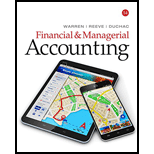
Financial & Managerial Accounting
14th Edition
ISBN: 9781337119207
Author: Carl Warren, James M. Reeve, Jonathan Duchac
Publisher: Cengage Learning
expand_more
expand_more
format_list_bulleted
Concept explainers
Question
Chapter 6, Problem 6.10EX
To determine
Perpetual Inventory System:
Perpetual Inventory System refers to the inventory system that maintains the detailed records of every inventory transactions related to purchases, and sales on a continuous basis. It shows the exact on-hand-inventory at any point of time.
First-in-First-Out method:
In First-in-First-Out method, the costs of the initially purchased items are considered as cost of goods sold, for the items which are sold first. The cost of merchandise sold is calculated by adding all the total cost of merchandise sold during the month. The value of the ending inventory consists of the recent purchased items.
To determine: cost of merchandise sold for each sale and inventory balance as on December 31.
Expert Solution & Answer
Want to see the full answer?
Check out a sample textbook solution
Students have asked these similar questions
General accounting
1) What is the scope of the act?
2) Discuss the class of person's that must abide by the act.
3) Discuss the enforcement of the act.
4) List at least 3 requirements of the act.
hi expert please help me subject-general accounting
Chapter 6 Solutions
Financial & Managerial Accounting
Ch. 6 - Before inventory purchases are recorded, the...Ch. 6 - Why is it important to periodically take a...Ch. 6 - Do the terms FIFO, LIFO, and weighted average...Ch. 6 - If inventory is being valued at cost and the price...Ch. 6 - Which of the three methods of inventory...Ch. 6 - If inventory is being valued at cost and the price...Ch. 6 - Using the following data, how should the inventory...Ch. 6 - Prob. 8DQCh. 6 - Hutch Co. sold merchandise to Bibbins Company on...Ch. 6 - A manufacturer shipped merchandise to a retailer...
Ch. 6 - Cost flow methods The following three identical...Ch. 6 - Perpetual inventory using FIFO Beginning...Ch. 6 - Perpetual inventory using LIFO Beginning...Ch. 6 - Perpetual inventory using weighted average...Ch. 6 - Periodic inventory using FIFO, UFO, and weighted...Ch. 6 - Lower-of-cost-or-market method On the basis of the...Ch. 6 - Effect of inventory errors During the taking of...Ch. 6 - Control of inventories Triple Creek Hardware Store...Ch. 6 - Prob. 6.2EXCh. 6 - Perpetual inventory using FIFO Beginning...Ch. 6 - Perpetual inventory using LIFO Assume that the...Ch. 6 - Perpetual inventory using LIFO Beginning...Ch. 6 - Prob. 6.6EXCh. 6 - FIFO and UFO costs under perpetual inventory...Ch. 6 - Weighted average cost flow method under perpetual...Ch. 6 - Weighted average cost flow method under perpetual...Ch. 6 - Prob. 6.10EXCh. 6 - Perpetual inventory using LIFO Assume that the...Ch. 6 - Periodic inventory by three methods The units of...Ch. 6 - Periodic inventory by three methods; cost of goods...Ch. 6 - Comparing inventory methods Assume that a firm...Ch. 6 - Lower-of-cost-or-market inventory On the basis of...Ch. 6 - Prob. 6.16EXCh. 6 - Effect of errors n physical inventory Madison...Ch. 6 - Effect of errors in physical inventory Fonda...Ch. 6 - Prob. 6.19EXCh. 6 - Prob. 6.20EXCh. 6 - Retail method A business using the retail method...Ch. 6 - Retail method A business using the retail method...Ch. 6 - Retail method On the basis of the following data,...Ch. 6 - Gross profit method The inventory was destroyed by...Ch. 6 - Prob. 6.25EXCh. 6 - Gross profit method Based on the following data,...Ch. 6 - FIFO perpetual inventory The beginning inventory...Ch. 6 - LIFO perpetual inventory The beginning inventory...Ch. 6 - Weighted average cost method with perpetual...Ch. 6 - Periodic inventory by three methods The beginning...Ch. 6 - Periodic inventory by three methods Dymac...Ch. 6 - Lower-of-cost-or-market inventory Data on the...Ch. 6 - Retail method; gross profit method Selected data...Ch. 6 - FIFO perpetual inventory The beginning inventory...Ch. 6 - LIFO perpetual inventory The beginning inventory...Ch. 6 - Weighted average cost method with perpetual...Ch. 6 - Periodic inventory by three methods The beginning...Ch. 6 - Prob. 6.5BPRCh. 6 - Lower-of-cost-or-market inventory Data on the...Ch. 6 - Prob. 6.7BPRCh. 6 - Prob. 1ADMCh. 6 - Costco, Walmart, Nordstrom: Inventory turnover and...Ch. 6 - Prob. 3ADMCh. 6 - Hewlett-Packard and Apple: Inventory turnover and...Ch. 6 - Prob. 6.1TIFCh. 6 - Communication Golden Eagle Company began...
Knowledge Booster
Learn more about
Need a deep-dive on the concept behind this application? Look no further. Learn more about this topic, accounting and related others by exploring similar questions and additional content below.Similar questions
arrow_back_ios
SEE MORE QUESTIONS
arrow_forward_ios
Recommended textbooks for you
 Financial And Managerial AccountingAccountingISBN:9781337902663Author:WARREN, Carl S.Publisher:Cengage Learning,
Financial And Managerial AccountingAccountingISBN:9781337902663Author:WARREN, Carl S.Publisher:Cengage Learning, Financial AccountingAccountingISBN:9781337272124Author:Carl Warren, James M. Reeve, Jonathan DuchacPublisher:Cengage Learning
Financial AccountingAccountingISBN:9781337272124Author:Carl Warren, James M. Reeve, Jonathan DuchacPublisher:Cengage Learning Financial AccountingAccountingISBN:9781305088436Author:Carl Warren, Jim Reeve, Jonathan DuchacPublisher:Cengage Learning
Financial AccountingAccountingISBN:9781305088436Author:Carl Warren, Jim Reeve, Jonathan DuchacPublisher:Cengage Learning Cornerstones of Financial AccountingAccountingISBN:9781337690881Author:Jay Rich, Jeff JonesPublisher:Cengage LearningPrinciples of Accounting Volume 1AccountingISBN:9781947172685Author:OpenStaxPublisher:OpenStax College
Cornerstones of Financial AccountingAccountingISBN:9781337690881Author:Jay Rich, Jeff JonesPublisher:Cengage LearningPrinciples of Accounting Volume 1AccountingISBN:9781947172685Author:OpenStaxPublisher:OpenStax College College Accounting, Chapters 1-27AccountingISBN:9781337794756Author:HEINTZ, James A.Publisher:Cengage Learning,
College Accounting, Chapters 1-27AccountingISBN:9781337794756Author:HEINTZ, James A.Publisher:Cengage Learning,

Financial And Managerial Accounting
Accounting
ISBN:9781337902663
Author:WARREN, Carl S.
Publisher:Cengage Learning,

Financial Accounting
Accounting
ISBN:9781337272124
Author:Carl Warren, James M. Reeve, Jonathan Duchac
Publisher:Cengage Learning

Financial Accounting
Accounting
ISBN:9781305088436
Author:Carl Warren, Jim Reeve, Jonathan Duchac
Publisher:Cengage Learning

Cornerstones of Financial Accounting
Accounting
ISBN:9781337690881
Author:Jay Rich, Jeff Jones
Publisher:Cengage Learning

Principles of Accounting Volume 1
Accounting
ISBN:9781947172685
Author:OpenStax
Publisher:OpenStax College

College Accounting, Chapters 1-27
Accounting
ISBN:9781337794756
Author:HEINTZ, James A.
Publisher:Cengage Learning,
Chapter 6 Merchandise Inventory; Author: Vicki Stewart;https://www.youtube.com/watch?v=DnrcQLD2yKU;License: Standard YouTube License, CC-BY
Accounting for Merchandising Operations Recording Purchases of Merchandise; Author: Socrat Ghadban;https://www.youtube.com/watch?v=iQp5UoYpG20;License: Standard Youtube License